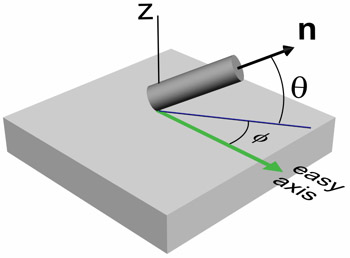6. Surface Anchoring
Almost any surface causes the director n orient
in a specific direction near the surface. The molecules
alignment at surfaces propagates over macroscopic distances.
There are three main types of the LC director n alignment near
solid wall or at the free surface. These are homeotropic, planar,
and tilted orientations (Fig16). The surface, which is in a contact
with mesophase is usually considered to be flat on the microscopic
scale, and the position of the director near it is determined by
polar θ and azimuthal φ angles (Fig.17).
|
Figure 16. Types of liquid crystals
orientation near surface: |

|
|
Figure 17. Position of director n near surface is determined by polar θ and azimuthal φ angles |
When the director n is oriented homeotropically, the polar angle θ = 90o. The director with planar orientation lies in the plane of the surface or phase separation border. In this case two possible orientations exist: one, homogeneous planar orientation, when the director is oriented uniformly over the surface and φ is fixed; another, heterogeneous planar orientation, when the orientation of the director is not uniform over the surface and φ has different fixed values in different points of the surface. In case of tilted orientation θ is fixed and φ is arbitrary. The preffered direction of the director n at the surfaces set by alignment is called “easy axis”.
Due to the deformations of LCs there are deviations of the director from the “easy axis” in the areas adjacent to surfaces. Thus, to the distortion free energy should be added term related to the excess surface energy. This surface anchoring term is given by
Fs = 1/2 Wθosin2(θ - θo) + 1/2 Wφosin2(φ - φo),
where θo and φo are fixed polar and azimuthal angles of “easy axis”; Wθo and Wφo are polar and azimuthal anchoring potentials defining the energy needed for the maximal deviation of the director from the “easy axis” position. The surface anchoring is considered to be strong in the range ~10-4J/m2 and weak in the range ~10-6J/m2. The important parameter characterizing the surface anchoring strength is the extrapolation length given by L~K/W, where K is an elastic constant and W is a surface anchoring coefficient. The extrapolation length means the distance from the real surface where the director would coincide with the “easy axis” orientation. If W is infinitely large L = 0 and the director coincides with easy axis orientation near the surface.
To orient the LC, it is necessary to treat the surface in some way. All procedures of solid substrate treatment can be roughly divided into two major groups: mechanical treatment and chemical treatment. The simplest way to get homogeneous planar orientation of the director is to rub surface with velvet cloth in some defined direction. In order to get homeotropic orientation substrates can be washed with surfactant, lecithin for example. Tilted orientation can be obtained with the oblique evaporation of the SiO thin film on the substrate surface.
Prev
Smectics
Next
LCs in external fields